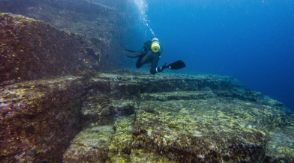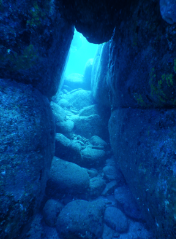Deep sea ruins have been items of legend for centuries. With the inception of tales like the lost city of Atlantis and shipwrecks full of buried treasure, daring divers and eager explorers have always been on the hunt for something special. Some underwater sea phenomena, though, remain almost entirely unknown and have origins not even scientists can explain. If the decorations scattered throughout Easter Island seemed very eerie, a similar situation has occurred off the coast of Japan—under the water. The Yonaguni Monument is a mystery that has been explored for decades, but what exactly is this mysterious object?
Kihachiro Aratake was a diver exploring some waters off the coast of Japan for the levels of hammerhead sharks when he stumbled upon something much more interesting. His discovery near Yonaguni Island in Okinawa started small, as he noticed a rock that seemed entirely out of place. Investigating it more closely revealed a structure that was absolutely massive, especially among the shallow water it was discovered in. The 20 million-year-old structure was intricately detailed with a pyramid-like structure, steps, and other features. It stood around 82 feet tall and was a marvel unlike anything Aratake had ever seen before. 
Following its discovery, researchers, professors, and scientists jumped at the opportunity to investigate this marvel. The University of Ryukyus’ Masaaki Kimura believes that this structure represents a much larger piece of Japanese history, indicative of a possibly ancient civilization that was buried by an earthquake. Kimura has been exploring the discovery for more than 15 years and has shared his beliefs with the world through conventions and research. He hypothesizes that it is over 10,000 years old and is a remnant of a sunken continent. The frequent seismic activity in Japan and its placement in the Ring of Fire support Kimura’s idea of its destruction since a disaster could have easily destroyed an unprepared society.
Kimura’s findings in his initial investigation swayed what he initially believed. As he dove, Kimura discovered what appeared to be carved characters and animals. He also claims to have unveiled structures that resemble places that would be a part of a city, like temples, arches, a stadium, and even a castle, which are connected via pathways and channels. He also states that some charcoal remains have been discovered nearby dating around 1600 years ago, indicating human activity.
 The hypothetical continent, Mu, is part of a legend that concludes the whole landmass was brought to the depths of the oceans and forced its survivors to travel to many different parts of the world. Kimura is a big advocate of this idea since the exact details of the Yonaguni Monument suggest the handiwork of humans from thousands of years ago. Others who lean into this theory suggest that the Jomon people, who are the ancestors of the Yamato Japanese people, helped to construct this when they lived on Japanese land.
The hypothetical continent, Mu, is part of a legend that concludes the whole landmass was brought to the depths of the oceans and forced its survivors to travel to many different parts of the world. Kimura is a big advocate of this idea since the exact details of the Yonaguni Monument suggest the handiwork of humans from thousands of years ago. Others who lean into this theory suggest that the Jomon people, who are the ancestors of the Yamato Japanese people, helped to construct this when they lived on Japanese land.
One professor, Toru Ouchi at Kobe University, agrees with Kimura’s ideas. His interactions with the ruins have led him to believe that these were entirely human made. Some of the ideas that Ouchi and Kimura support, though, can easily be disproven. The holes in the rock that were supposedly used as support were more accurately determined to be the work of marine creatures. The scratches and details that appeared at the site were also likely caused by animals floating by.
Others, like Boston University’s Robert Schoch, theorize that the Yonaguni Monument is simply the work of nature. Its position in the water created a series of bedding layers that can easily separate, creating the very fine lines that exist on it today. The precision is reminiscent of angles found in nature and are common as sandstone erodes against strong currents. Another possibility is that tectonic activity influenced the shape of the rock to a degree that created the shapes it now sports. 
Kimura’s idea that some rocks surrounding the pyramid appear as animals is also likely false. The phenomenon known as pareidolia allows people to see faces in objects that do not have them, like cars and electrical outlets. Additionally, the steps, despite how precise they are, cannot be climbed due to their size and height differences.
The Japanese government has not designated this monument as an area of historical significance, so anyone can go explore its ruins as they please. They have not made an active effort to investigate these features either, lacking the desire to pursue preservation since it is likely just a natural happenstance. So, anyone could go and find what they want for themselves. If you ever find yourself in Japan, consider determining for yourself what you believe the Yonaguni Monument could possibly mean.
Resources:
https://explorersweb.com/exploration-mysteries-yonaguni-monument/
https://www.nationalgeographic.com/history/article/yonaguni-jima-japan-underwater-city





















































